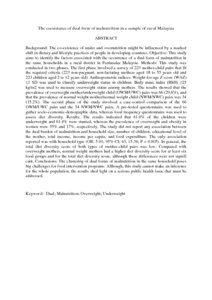Citation
Ali Naser, Ihab and Abdul Jalil, Rohana and Wan Muda, Wan Manan and Wan Nik, Wan Suriati and Mohamed Sharif, Zalilah and Abdullah, Mohamed Rusli
(2013)
The coexistence of dual form of malnutrition in a sample of rural Malaysia.
International Journal of Preventive Medicine, 4 (6).
pp. 690-699.
ISSN 2008-7802; ESSN: 2008-8213
Abstract
Background: The co-existence of under and overnutrition might be influenced by a marked shift in dietary and lifestyle practices of people in developing countries.
Objective: This study aims to identify the factors associated with the occurrence of a dual form of malnutrition in the same households in a rural district in Peninsular Malaysia.
Methods: This study was conducted in two phases. The first phase involved a survey of 223 mother-child pairs that fit the required criteria (223 non-pregnant, non-lactating mothers aged 18 to 55 years old and 223 children aged 2 to 12 years old). Anthropometric indices: Weight-for-age Z score (WAZ) ≤1 SD was used to classify underweight status in children. Body mass index (BMI) ≥25 kg/m2 was used to measure overweight status among mothers. The results showed that the prevalence of overweight mother/underweight child (OWM/UWC) pairs was 66 (29.6%), and that the prevalence of normal weight mother/normal weight child (NWM/NWC) pairs was 34 (15.2%). The second phase of the study involved a case-control comparison of the 66 OWM/UWC pairs and the 34 NWM/NWC pairs. A pre-tested questionnaire was used to gather socio-economic-demographic data, whereas food frequency questionnaire was used to assess diet diversity.
Results: The results indicated that 61.0% of the children were underweight and 61.4% were stunted, whereas the prevalence of overweight and obesity in women were 35% and 17%, respectively. The study did not report any association between the dual burden of malnutrition and household size, number of children, educational level of the mother, total income, income per capita, and food expenditure. The only association reported was with household type (OR: 5.01; 95% CI; 63, 15.34; P = 0.005). In general, the total diet diversity score of both types of mother-child pairs was low. Compared with overweight mothers, normal weight mothers had a higher diet diversity score for at least six food groups and for the total diet diversity score, although these differences were not signifi cant.
Conclusions: The clustering of dual forms of malnutrition in the same household poses big challenges for food intervention programs. Although, this study cannot make an inference for the whole population, the results shed light on a serious public health issue that must be addressed.
Download File
![[img]](http://psasir.upm.edu.my/29726/1.hassmallThumbnailVersion/The%20coexistence%20of%20dual%20form%20of%20malnutrition%20in%20a%20sample%20of%20rural%20Malaysia.pdf)  Preview |
|
PDF (Abstract)
The coexistence of dual form of malnutrition in a sample of rural Malaysia.pdf
Download (190kB)
| Preview
|
|
Additional Metadata
Actions (login required)
 |
View Item |

